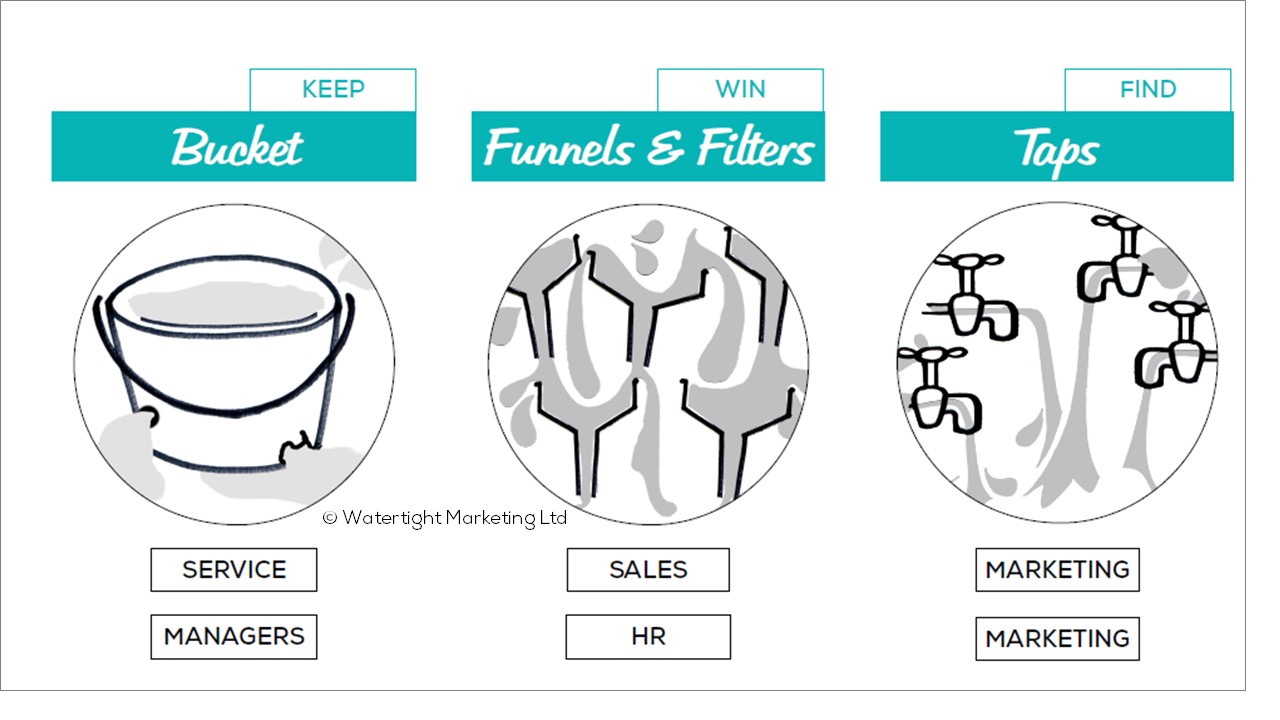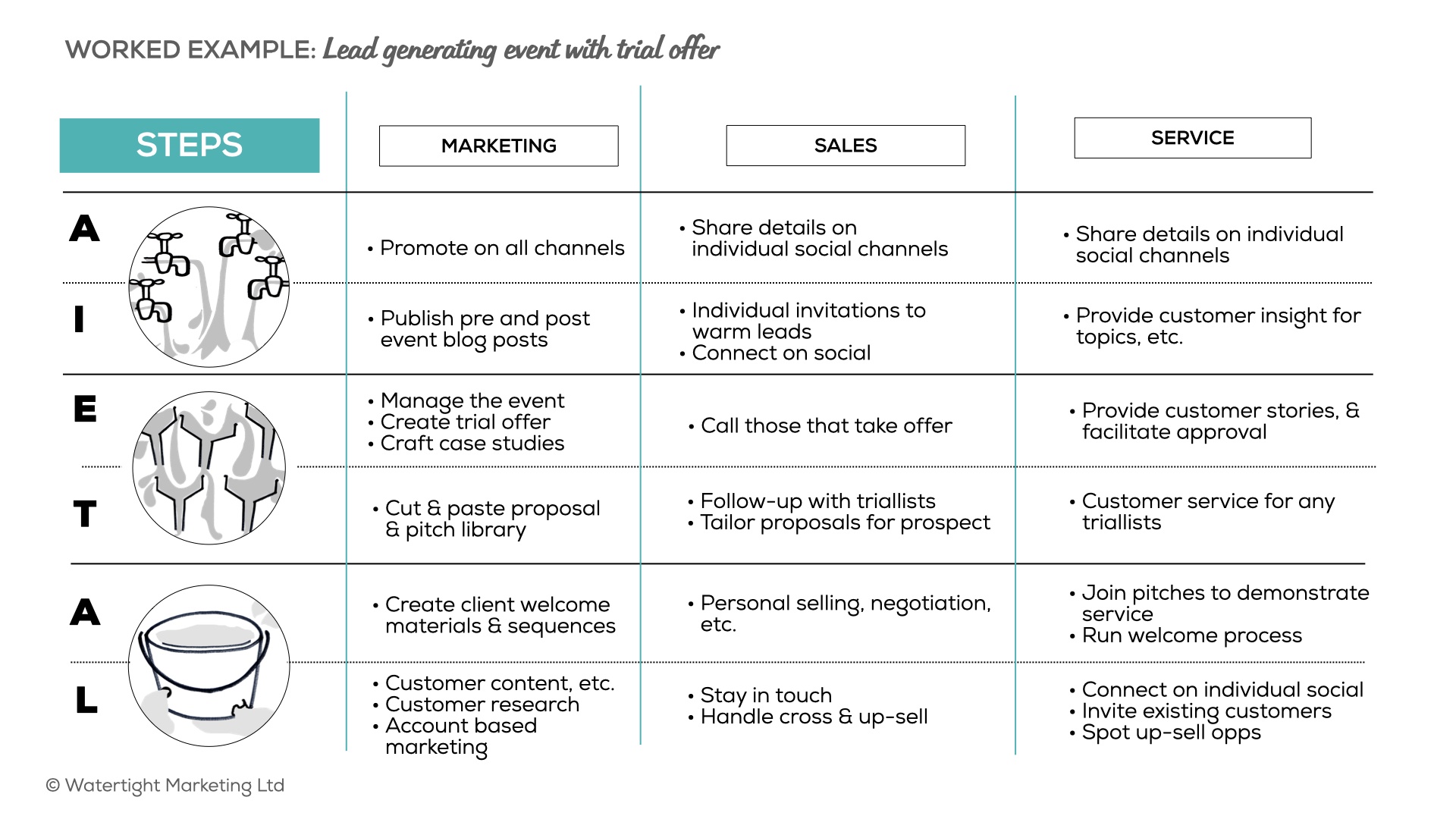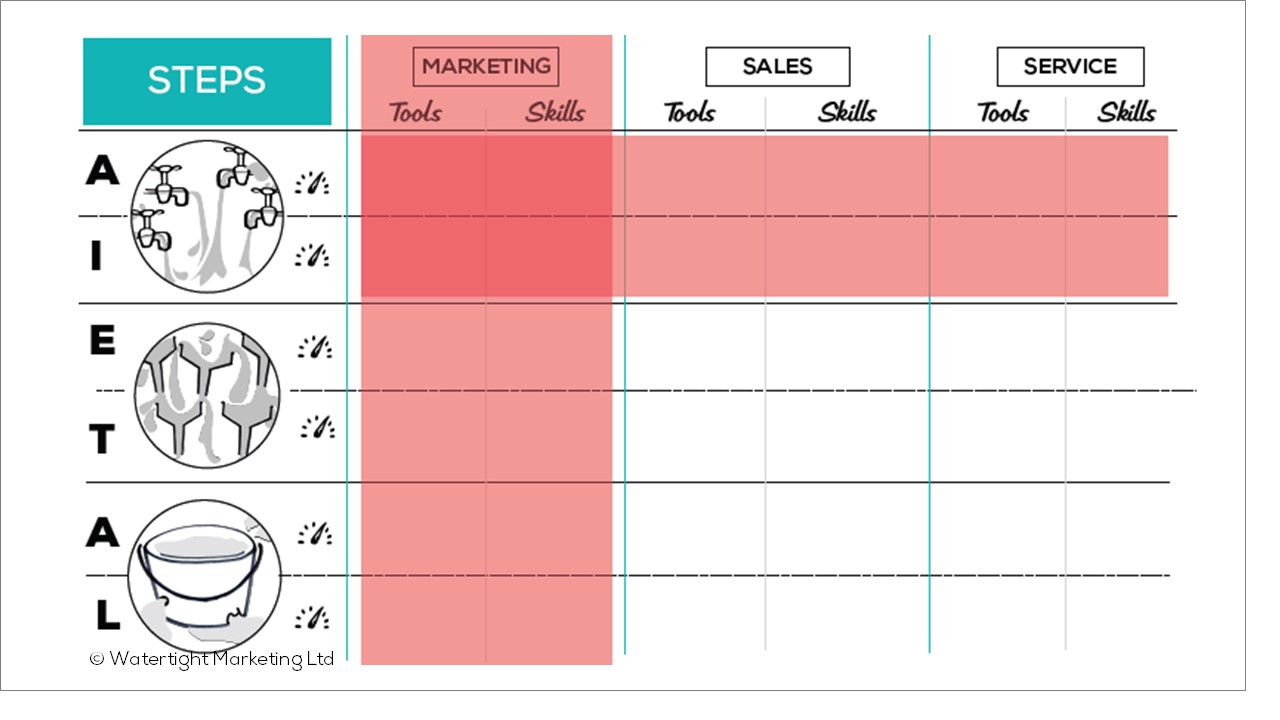Reading Time: 10 Minutes
“10 years ago the Chartered Institute of Marketing predicted that there would be no separation between sales and marketing. Clearly that hasn’t happened, but why is that? And why does service get left out?” ~ Rachael Wheatley, Managing Director | Watertight Business Thinking
Listen to the session podcast here
60-minute roundtable discussion on creating seamless marketing, sales and service teams
This was the starting point for our roundtable discussion this month. The prediction from the CIM was within a report they published in 2012 setting out a strong case for a unified department, the result being to improve growth and profit, present both marketing and sales in a more commercial light and future-proof businesses.
Given the huge benefits, it is curious how the norm still entails separate departments, even if there is more coordination, communication and collaboration between sales, marketing and service teams.
To set the context and propose how this might be set up in businesses, Bryony started by talking about the customer journey: buckets (existing business and clients), funnels and filters (warm prospects with whom you are engaging) and taps (people aware of and interested in what you do).
In most organisations what we see are people with service in their job title supporting the bucket section, those with sales as their responsibility supporting the funnels and filters section and those in marketing expected to be the lead generators.
If this were an employee journey (another example of a decision journey), you’d have the line managers at buckets, keeping their teams happy and in the business; you’d normally have HR helping you to select candidates and you might go to marketing to help you run a recruitment campaign and encourage people to apply for jobs.

Who takes the lead, when?
One way of looking at who takes the lead is via a heatmap, which we’ve explained before in this blog. At different stages, there’s always someone taking the heavier load, supported by the other two teams. It wouldn’t be possible to operate without all three people (think, a three-handled sedan chair – another of Bryony’s metaphors!).
- At the Taps stage, marketing takes the lead and the heavier load, with service and sales at the back
- At Funnels & Filters, sales takes the lead and
- At the Bucket stage, service takes the lead.
The important point here is their interdependence. Take, for example, a lead generating event with a trial offer. Outlined below are the kind of activities marketing, sales and service could do to support the whole customer journey. It has so much more impact and effect if everyone is doing something at each point – and gives the customer a seamless experience.

Consider what tools you have or need to put in place as well as the skills required at each stage. Tools are contained within a system or process and can be re-used multiple times. Skills reside within people so are dependent on capacity and capability of that person. In an ideal world, every step of a customer journey will have skills and tools mapped to them so you can understand what’s needed, who does what and where the gaps or pinch points might be.
In this way, the head of marketing is responsible across the Taps stage (Awareness and Interest) and ensuring that skills and tools are mapped fully for Taps. They also have a responsibility all the way down to make sure that their skills and tools are available for across the customer’s journey. Similarly for a head of sales and a head of service who both have a matrix responsibility. Each team has their own metrics for where they lead, but the key metric which is a joint responsibility is conversion from one stage to the next.

“In an ideal world you would also have a tool that does what a sales person does, so people can self-qualify. Something they read on the website or a diagnostic quiz that tells them they’re not right for you. That tool will make life easier for the skilled person. Every skill should be backed up with a tool and every tool should be mapped to a skill.” Bryony Thomas.
How do we achieve this?
Rachael Wheatley: “When I first started work, I was part of a joint sales and marketing department, run by one person. All of the sales and marketing team had regular and direct conversation with customer service. For me, one of the key ways to achieve it is to have one reporting line.”
“Looking at a matrix structure, as explained above, who would these heads of report to? The MD, the Head of Customer Experience? It might explain where role of a something like a Chief Revenue Officer comes from,” Bryony added.
Bryony Thomas: One of the reasons they’re often separated out as they are quite characteristically different. Perhaps that’s the reason why that prediction hasn’t come true.
Cheryl Crichton: “I’ve worked in all sizes of offices and sitting next to someone is different from being in a separate building or floor. Ideally, you’d co-locate these teams to facilitate working together. Difficult if you’re accommodating home-working – which is where the importance of internal comms comes to the fore.”
“And even if you do have separate teams and it’s not in your purview to combine them, I would suggest that at least quarterly, you get together (even if that’s a virtual session) and look at that heat map. Discuss what you do, where it fits, who handles what, what your plans are and make it fit together. Encourage people to bring back ideas from the field and pin it on the wall, where it fits in. Make it fun!” Bryony Thomas.
Lines can be blurred – but that encourages joint responsibility
Maggie Mutkovicova described where she used to work, which had a few offices throughout the UK. There were no sales people – the consultants were expected to fulfil that role. “The chart you used before made me think: no wonder that they were overwhelmed and couldn’t give marketing the support we needed, because they were trying to do service and sales and deliver on all their client work.
“And”, she continued, “it worked well when we agreed on the same goal. It’s when different teams were given different goals that things didn’t connect and it was hard to see how working together would help.”
“That’s why”, Bryony responded “I think the joint metrics should be the ratios: all aiming for x conversions on leads because that allows marketing to generate the right kinds of leads and it means sales are following up on them. It’s a joint responsibility and accountability.”
Lucy Barrott: “We don’t have a sales department but we do draw a line between what’s marketing or sales and what’s client care (i.e. what our lawyers do). It’s easy to hand over a project to the other team but they need the right information and we need to decide what works best for each project or journey.”
There can be a blurring of roles, depending on what kind of business you’re in. Lawyers act as sales people as well as customer service, for instance. “I think it’s about maybe knowing what hat you’re wearing at a given moment. It would still be interesting to do the matrix exercise and understand when in the process you’re wearing which hat and therefore what skills and tools to draw on.” Bryony Thomas.
How marketing, sales and service can help each other – the importance of connectedness
Frank Mavin: “I’m in a sales role. Historically, we separated out marketing and sales and we’ve been working recently to join those two together. I’ve noticed that there’s a middle area that no one really wanted to be responsible for. That gap was between the generating of awareness and booking a meeting with a sales person.”
This middle ground is often the conversations that people have with prospects. If you go straight from Taps to Bucket it’s a recipe for the wrong work because you’re focused on winning anything that comes in and not being selective. “And if you have a complex offering and are seeking a long-term commitment, that doesn’t happen from a tweet!” Bryony Thomas.
Frank Mavin again: “We have a very similar challenge. The messaging that’s put out before needs to resonate with what we in the sales team talk about through several conversations. That’s led to me writing 1000s of words of copy to help marketing.”
“And that’s great – the substance on which the taps is based does absolutely come from downstream, conversations with sales or service people and questions they’re asked. If marketing aren’t involved downstream, content is poor or disconnected.” Bryony Thomas.
Laura Page: “I’m in a fortunate position where I work because the owner is a marketing-led guy. What really influences things is our cost of acquisition and how profitable we can make things; we talk about this throughout the whole business to try and reduce it, so we are naturally more aligned. And marketing and sales both come into me.”
Bryony Thomas: “I would add, that the cost of acquisition should be set against customer lifetime value. How long a customer stays, what they buy over a period of time, is a combined piece. Customer lifetime value, total cost of acquisition and ratios are all things where people are jointly responsible. You may not need to lower your cost of acquisition; you might need to increase your customer lifetime value.”
There’s also a risk with reducing costs. If you’re selling a high value product, the cost of acquisition might legitimately be higher. “People expect quite a lot of nurturing and good quality marketing collateral. It has to be matched and congruent with what you’re selling. If you’re only focused on reducing the cost of acquisition, you could be harming your business.” Rachael Wheatley
And in fact, chasing the wrong work is expensive. “Understanding that is really valuable. If you can illustrate to your team that having the wrong work is a cost and that being able to shut that down and redirect someone to a more appropriate use of their time is more profitable.” Cheryl Crichton.
Numbers are great, but they need to manifest the right behaviour
Cheryl Crichton: “It’s about understanding the common goal for business as well. The more teams understand each other, the more they’ll understand how their bit contributes and how they can work together. It helps to motivate and encourages empathy.”
“Reflecting back on when we worked together, we would have a meeting every morning where everyone gave a rundown of what they were working on, their priorities, challenges, what was on their plate. You’d start to spot how what you’re doing connects with what other people are handling.” Bryony Thomas.
It links to making sure that the metric you’re measured on encourages the right behaviour. So if you’re measured on the number of times the phone rings, rather than the kind of person who’s enquiring, you could be wasting a lot of money getting the wrong kind of customers.
Laura Page added: “That’s why it’s so good we’re aligned. From a marketing perspective, the main goal is literally make the phone ring, we’re targeted on X amount of calls a day. You could quite easily fill that up with rubbish using lower quality keywords. But having the joint responsibilities, I’ve got to then turn those into bookings in sales, so they’ve got to be good quality.”
Frank Mavin: “The way we’ve tried to solve that is instead of how many enquiries we get, we look at how many qualified leads we get. So following that first call, how many of those have a genuine project where they’ve got the money to pay for it and it sounds like the right kind of work for us. Marketing and sales are looking for them at the same time.”
Watertight Wisdom
What’s worked for us
Ideas from the group about how to shift the context in their organisation to be not just benign, but nourishing:
- Facilitate coming together if you’re not in one team. Regular meetings, a cross-team project, regular brainstorming or sharing of plans.
- Quarterly sessions between the teams to share war stories or talk about what you’re doing
- Map out your projects and pin what you’re doing at the right place in the customer journey. Connect it all up.
- Use the matrix diagram to help you do this and identify where the gaps are.
- Help each other. Spot ways in which you can add value – the tool you’ve already created that will help the sales person; the question that repeatedly comes up in conversation that will provide great content.
- Have joint metrics for which there is shared responsibility and accountability.
- Align metrics with the behaviour you want to encourage.
- Recognise that no one team can do everything. Create tools for every step of the journey to make life easier for marketing, sales and service people.
What would you add to our list? Do let us know your thoughts.
To join the conversation at our next Watertight Wednesday marketing roundtable you can sign up here. Next time we’ll be having a chin-wag about how marketing can support different kinds of growth: lifetime value, margin and volume.

Rachael Wheatley
Managing Director, Watertight Thinking
Rachael brings over 30 years’ of marketing experience, with a particular focus on building and developing effective marketing teams that are able to act as a strategic driving force across an organisation. She has worked with Watertight since 2014 as a Master Practitioner and joined the business as MD in 2022.



